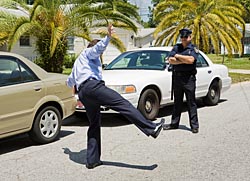One-Leg Stand Field Sobriety Test
 |
|---|
The one-leg stand is a standardized field sobriety test utilized by police officers to determine if a driver is under the influence of drugs or alcohol. Similar to the walk-and-turn test, the one-leg stand test is a divided attention test. In other words, the one-leg stand test requires a subject to divide his attention between the mental task of following oral instructions and the physical task of balancing on one foot for thirty seconds.
To complete the one-leg stand test, you must stand with one foot approximately six inches off the ground with your toe pointed. While maintaining perfect balance, you have to count by thousands (one thousand-one, one thousand-two, etc.) for thirty seconds. Meanwhile, your arms must remain at your side. Finally, you must look down at your foot. While you are completing this test, the police officer will observe you for the presence of indicators of impairment. If the police officer concludes that you exhibit two or more of the indicators, you could be arrested for driving under the influence of drugs or alcohol. The indicators include the following:
(1) putting your foot down before the test is completed; (2) swaying while trying to maintain your balance; (3) hopping while trying to maintain your balance; and (4) using your arms to help maintain your balance.
Sound complicated? Critics of the one-leg stand test contend that it is designed to fail. That is to say, it is difficult for a sober person under the most ideal circumstances to successfully perform this test. Yet this test is typically administered on the side of a road, often at night, when the distractions can be numerous.
For example, the shoulder of the road might be uneven or covered in gravel; cars may be passing at a high rate of speed; the blue lights on the police officer’s patrol car might be glaring in your eyes; etc. Additionally, people who are overweight, people over the age of 65 and people who have any kind of physical limitation may be unable to perform the one-leg stand test.